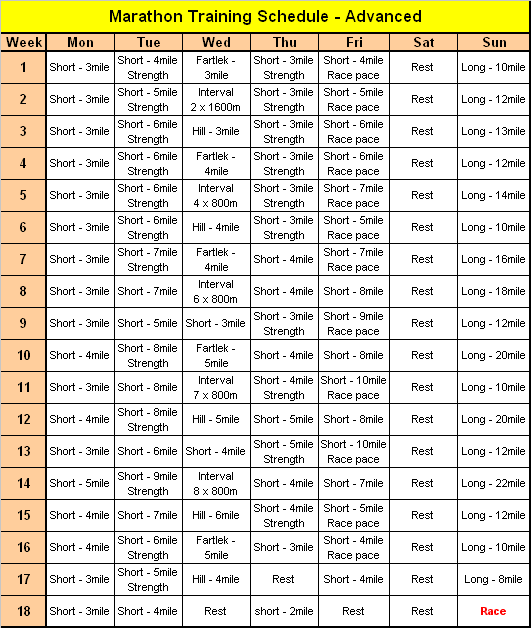The marathon training plan below has been designed with advanced endurance athletes in mind. You'll also find two other programs in this section of the site... one for Beginners and one for Intermediate runners.
This is a very demanding program...
Few have the time or inclination to train to this extreme. If you consider yourself an advanced marathon runner, it's important you meet the following criteria..
- You should have considerable marathon experience and be well used to training for such an event
- You should be currently running 30-40 miles per week, over 5-6 sessions
- Thirdly, you should comfortably be able to run at least 10 miles
If you don't meet one or more of these provisos, seriously consider the beginner or Intermediate marathon training plans.
Finally, this marathon training plan pre-supposes that your are in good health and you've had medical screening before you begin. Please read the disclaimer before you attempt any for of training program.
Marathon Training Plan Fundamentals
As an experienced distance runner, you'll already be aware of many of the general principles of training AND those unique to marathon training. Below are some of the most important considerations for an advanced marathon training plan. Don't skip them - these are four of the main parameters that let many runners down - preventing them from tapping their full potential come race day...
Over-Training
It's the more experienced athletes that are prone to over-training. They have a greater tolerance to discomfort so they are less likely to adhere to their body's demands for rest. Couple that with a false logic that more training miles equates directly to greater fitness and the result is over-training. One of the biggest mistakes you can make is to perform your long runs at your target race pace. More on this below.
Tapering
If over-training during the plan is a problem, too many miles in the month leading up to the race is perhaps the number one error found in a typical marathon training plan. Aim to reach a peak (in terms of distance) 4 weeks prior to the race itself. Avoid runs longer than 10 miles during this last month - it can take that amount of time for ligaments, tendons and connective tissue etc. to fully recover.
Adequate Variety
The average marathon training plan is very monotonous and uninspiring. Covering 60 plus miles per week, at a continuous pace can quickly lead to mental and physical stagnation. Adding a few tempo runs here and there is not enough. Instead, incorporate interval training, fartlek training, hill climbs and some running-specific strength and power exercises. Not only will they help to keep you mentally fresh, there are sound physiological reasons for perform shorter, more intense training sessions during the week.
Strength Training
So long as it's specific to long distance running, strength conditioning is an important and beneficial adjunct to running sessions. Not only can it improve running gait and economy, strength conditioning can also prevent and reverse the imbalances inherent with any long-term, repetitive training.
Marathon Training Sessions
The marathon training plan below is made up of six individual sessions. Below is a description of each.
If you have a course set out with distance markers that's fine. Or use a pedometer to log training miles. As an experienced distance runner you should also have an idea of your goal race pace...
Long Distance Runs
Remember, long runs in this marathon training plan are NOT run at race pace - save that for shorter sessions. There is also one long run per week. "Long" is a relative term and you'll notice that as the plan progresses some shorter runs will be lengthier than your early long runs.
Renowned Marathon coach Hal Higdon, recommends running long runs at a pace 45 to 90 seconds slower per mile than your goal marathon pace.
Here is the format for our Long runs...
Warm up: 5-10 minutes of slow jogging (these can count towards your mileage)
Distance: Varies from 10 miles up to 22 miles as program progresses (see chart at bottom of page)
Intensity: 45-90 seconds below target race pace
Cool Down: Finish with 10 minutes of brisk walking or slow jogging (these can count as part of your miles)
Short Runs
Again, the term "short" is relative. It's simply a way to distinguish from the long run. The short run is performed at a comfortable pace - faster than the long run but still below race pace unless otherwise indicated.
Here is the format for our Short runs...
Warm Up: 5-10 minutes of light jogging
Duration: 3-10 miles (see chart below)
Intensity: Moderate - up to race pace where indicated
Cool down: 5-10 minutes of light jogging followed by stretching exercises
Fartlek Runs
These are shorter sessions made up of jogging, walking and some fast running. Along with Interval Training and Hill Climbs, Fartlek training will help to improve lactate tolerance and in some cases VO2max. These are the sessions performed at or above race pace.
Here is the format for our Fartlek sessions...
Warm Up with 5-10 minutes of light jogging
Run for 4 minutes, jog slowly/walk for 1 minute. This is one cycle
Repeat over the prescribed amount of distance (see chart at bottom).
On a scale of 1 to 10 (10 is a very fast run, 1 is a leisurely stroll) aim for a level 7 to 8 on the runs
Cool down for 5-10 minutes of light jogging followed by stretching to all major muscle groups
Interval Runs
No doubt you are familiar with the concept of interval training. For the uninitiated, it's simply bouts of intense activity separated with short, active rest periods. Using this approach you can exercise at a higher intensity without fatiguing.
An example might consist of 4 lots of 800m ran at faster than target race pace, interspersed with 2-3 minutes (or 400m) of slow jogging.
Here is the format for our Interval sessions...
Warm Up: 5-10 minutes of light jogging
Duration: varies (see chart below)
Intensity: Moderate-Intense. 800m runs are faster than target marathon pace
Cool down: 5-10 minutes of light jogging followed by stretching to all major muscle groups
Hill Climbs
This is very similar to interval training session. Hill running provides additional resistance and offers a nice change of pace to flat running. It's beneficial even if your marathon is flat. Find a hill roughly 400m long. If it's longer then simply run 400m before turning round.
The format is the same also for interval training only with 400m splits rather than 800m. Be sure to get your rest between each hill climb as you jog slowly back down to the start.
Here is the format for our Hill Climb sessions...
Warm Up: 5-10 minutes of light jogging
Duration: varies (see chart below)
Intensity: Intense. Each 400m interval should be run quickly - a level 7 or 8 out of 10
Cool down: 5-10 minutes of light jogging followed bystretching to all major muscle groups
Strength Sessions
The advanced marathon training plan starts with 6 weeks of strength training 2days per week. Two sessions are scheduled in while weekly mileage is still relatively low. This 6week period will allow you to form a solid base of strength on which more sport-specific strength can be built.
As the program progresses the number of strength sessions reduces - particularly on weeks following near-marathon length runs. Important note: If you are particularly sore or fatigued going into a strength session - miss it out. If your muscles haven't fully recovered from a strenuous run, a weights session will be more detrimental than it will beneficial.
Stick also to full body, compound exercises. This is more specific to running than isolating body parts as bodybuilders do. Circuit training is an excellent format to follow. Just be sure to use lighter weights and higher numbers of repetitions (20+ reps).
Box Step with Knee Drive: 2-3sets x 15reps (each leg)
Bench Dips: 2-3sets x 15-20reps
Dumbbell lunges: 2-3sets x 15reps (each leg)
Oblique crunches: 3sets x 20reps
Squat to presses: 2-3sets x 15reps
Push-ups: 2-3 sets x 15-20reps
One leg squats: 2-3 sets x 15reps (each leg)
Supermans: 3sets x 20reps
Cool down: 5-10 minutes of light jogging/walking and plenty of stretching
For descriptions on how to perform these exercises, see this list of circuit training exercises.
As the marathon training plan progresses (and after the initial 6week base period), you can add in some explosive movements such as single leg hops, bounding and other plyometric exercises.
Don't go overboard on these though - although they are not physically exhausting, too many ground contacts can lead to severe muscle soreness and even stress injuries.
Rest Day
There's only one but it's crucial. In fact you could argue it's the most important day in the marathon training plan.
Marathon Training Plan
Here is the full 18-week Advanced marathon training plan.
You can re-arrange days to fit your schedule - just be sure to allow adequate recovery following those 18-20 milers!

This is an example of a simple periodized marathon training plan - nothing overly complicated because it doesn't need to be.
While there ARE guidelines to follow, there is no exacting scientific formula. The best approach is to listen to your body...
An objective way to do this is to take your pulse first thing every morning before you step out of bed. It might average say 50 beats per minute at this time. If on any particular morning it is 60bpm or higher, that can be an early indication that you are overstretched and need additional time to recover. Take the day off or do some gentle cross-training.

No comments:
Post a Comment